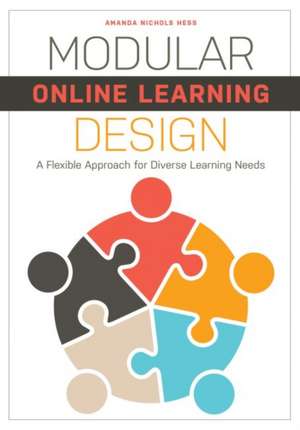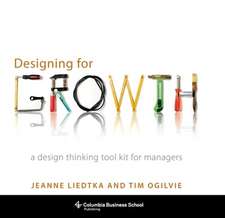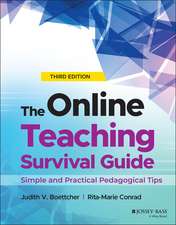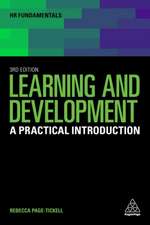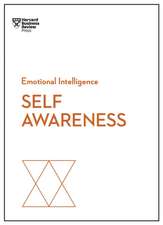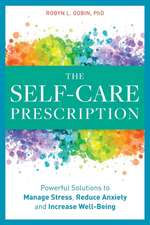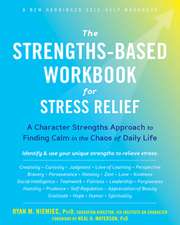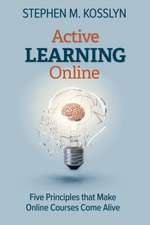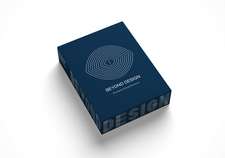Modular Online Learning Design: A Flexible Approach for Diverse Learning Needs
Autor Amanda Nichols Hessen Limba Engleză Paperback – 8 oct 2020
- the eight components of modular online learning design;
- key considerations for choosing the design model that best fits your organization and project;
- techniques for connecting your online learning goals with institutional strategy;
- using the IDEA process to align OER content with your instructional needs;
- documenting your planning with checklists, scaffolds, and templates;
- ensuring equity of access with all content formats using the Accessibility Inventory Index;
- principles for scaling up, down, or laterally;
- three models for more meaningful and functional collaboration with internal or external partners; and
- formative testing as a foundation for ongoing evaluation and assessment.
Preț: 504.30 lei
Nou
Puncte Express: 756
Preț estimativ în valută:
96.50€ • 101.01$ • 80.32£
96.50€ • 101.01$ • 80.32£
Carte tipărită la comandă
Livrare economică 31 martie-14 aprilie
Preluare comenzi: 021 569.72.76
Specificații
ISBN-13: 9780838948125
ISBN-10: 083894812X
Pagini: 144
Dimensiuni: 178 x 254 x 10 mm
Greutate: 0.29 kg
Editura: American Library Association
Colecția ALA Editions
ISBN-10: 083894812X
Pagini: 144
Dimensiuni: 178 x 254 x 10 mm
Greutate: 0.29 kg
Editura: American Library Association
Colecția ALA Editions
Recenzii
"Relevant to library staff in any setting who create learning objects such as video tutorials, self-paced modules, instructional handouts and subject guides. The example projects used and web resources suggested in the text are specific to academic libraries, but the structure of the design process and the planning tools are applicable to special, public and school libraries as well ... As a health sciences librarian in a hospital, I intend to apply some of the concepts and planning tools to the online learning resources that I create.”
— Journal of the Canadian Health Libraries Association
"Handy charts, checklists, and workflow models round out each chapter, and the comprehensive bibliography and index will be helpful ... Emphasizing flexibility and functionality, Hess's book will aid librarians who want to save time and energy when creating online learning content."
— Library Journal
"Various instructional design models are discussed, including ADDIE, ARCS, and the waterfall design. Also included are helpful charts and figures that make it easy for a visual learner to understand the concepts presented ... Recommended for librarians and instructional designers in academic libraries."
— Choice
— Journal of the Canadian Health Libraries Association
"Handy charts, checklists, and workflow models round out each chapter, and the comprehensive bibliography and index will be helpful ... Emphasizing flexibility and functionality, Hess's book will aid librarians who want to save time and energy when creating online learning content."
— Library Journal
"Various instructional design models are discussed, including ADDIE, ARCS, and the waterfall design. Also included are helpful charts and figures that make it easy for a visual learner to understand the concepts presented ... Recommended for librarians and instructional designers in academic libraries."
— Choice
Notă biografică
Amanda Nichols Hess is the e-learning, instructional technology, and education librarian at Oakland University in Rochester, Michigan. She holds a PhD in educational leadership, an Education Specialist certificate in instructional technology, and an MS in information. Her research focuses on information literacy, instructional design, online learning, and the intersections of these topics, particularly in library-centric professional learning. Her work has been published in College and Research Libraries, Communications in Information Literacy, Journal of Academic Librarianship, and portal: Libraries and the Academy, among other venues. Amanda also authored Transforming Academic Library Instruction: Changing Practices to Reflect Changed Perspectives (Rowman and Littlefield, 2019).
Descriere
Using this book as a roadmap, you'll learn how to more intentionally and strategically develop online learning objects to meet different learning needs both now and in the future.
